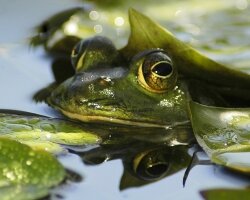Jeepers peepers! Frogs are canaries in a coal mine
By Amy Mathews Amos
The snow had melted, the sun was shining and the river beckoned, so I took a long walk by the water this weekend. Being outside was satisfying enough, but I got an unexpected treat: frogs.
I heard them first, croaking a chorus in shallow water, then was rewarded with a glimpse as one swam away. The daffodils haven’t bloomed yet, but the frogs told me spring is coming. It’s a scene that has delighted children and adults across America for centuries.
But what if next year, they’re gone?
Frogs, toads, and other amphibians are disappearing around the world at an alarming rate and scientists are trying to figure out why. A recent study points to at least one reason: pesticides.
Scientists have known for more than a decade that pesticides poison frogs, in some cases giving male frogs female parts. But a study published in the journal Scientific Reports this January shows that pesticides kill them too.
Researchers sprayed European common frogs with six formulations of chemicals regularly used on crops around the world, at the same doses utilized on fields. They even used the same kind of sprayer that commercial growers use. One pesticide killed all the frogs within one hour. Another killed them all within a week. In fact, all the common, currently used pesticides tested were deadly: A single spraying by each killed at least 40 percent of all frogs within a week.
If you ever caught a frog as a kid, or still catch them with your own kids today, you can easily understand why this happens. That slimy skin is permeable—frogs and other amphibians breathe through it. Air and water easily pass through it too. So whatever chemical pesticides get washed into a water body where amphibians live or breed, seeps inside their bodies.
More than 1,800 species of amphibians (frogs, toads, salamanders and their relatives) are now threatened or endangered—a third of all those on the planet, according to the International Union for the Conservation of Nature. More than a hundred species have vanished in the wild and at least nine have gone extinct since 1980. In some places, their forest and wetland habitats have been destroyed. In other places, people collect them for food. And as the climate changes globally, it warms and alters waters where amphibians breed, contributing to deadly diseases.
The U.S. Fish and Wildlife Service has listed 26 amphibian species threatened or endangered across the nation, in California, Arizona, Arkansas, Florida, Georgia, Mississippi, Missouri, Nevada, New Mexico, Puerto Rico, South Carolina, Texas, Virginia, West Virginia, and Wyoming.
Why should we care?
The sensitive, permeable skin of frogs and toads makes them early indicators of toxins in the environment that could harm other living things— including people. Amphibians also eat harmful insects, the reason farmers use pesticides in the first place. So it doesn’t make much sense to kill them off, especially when so much food can be grown organically and without pesticides.
Last year, U.S. and Canadian researchers reviewed dozens of scientific studies comparing organic and conventional food crops (grown with artificial pesticides and fertilizers), and reported their findings in the scientific journal Nature. They found that overall, crops grown with organic methods produce about three-fourths as much food as conventional methods using pesticides. Some organic crops, such as fruits, can yield nearly as much food as conventional techniques. Not bad when you consider all the frog lives saved, and all the insects they’ll eat. Additionally, the soil on organic farms holds water better than conventional farms; something worth considering as climate change worsens drought across the West, Midwest, and South.
It’s also something to think about this year when planting a garden or maintaining your lawn—can you do without chemical pesticides and fertilizers?
More than 50 years ago in her bestselling book, Silent Spring, biologist Rachel Carson warned of a spring with no bird song because of toxic DDT. Today’s scientists raise another question: will there soon be a springtime without spring peepers?
Amy Mathews Amos is an independent environmental consultant and a regular columnist for Blue Ridge Press ©Blue Ridge Press 2013.
